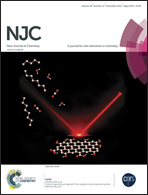Visible-emitting hybrid sol–gel materials comprising lanthanide ions: thin film behaviour and potential use as phosphors for solid-state lighting†
Abstract
The synthesis and characterization, as well as the film-forming and luminescent properties of four visible-emitting hybrid organic–inorganic sol–gel materials are reported. They show thermal stability up to 165 °C. Deposition conditions were optimized to coat these materials as homogeneous and transparent thin films (∼50 nm) of a smooth surface, as probed by AFM. They were specifically designed to emit the three primary colours. The blue-emitting material 1 was made up of a polyfluorene derivative embedded into a silica matrix, while the green (2) and red (3)-emissive materials comprise the TbIII and EuIII ions bound to the matrix, respectively. The films showed relatively high emission quantum yield efficiencies, with values of 19% (blue), 46% (green), and 21% (red). The three emitters were used to design a single emissive material (4) that showed emission from yellow-green to blue in a wide range of excitation wavelengths (254–380 nm). In particular, white light was obtained for excitation at 340 nm. The EuIII material was investigated as a potential phosphor coated on an UV LED, and primary investigations on its stability under operating conditions are reported.


 Please wait while we load your content...
Please wait while we load your content...